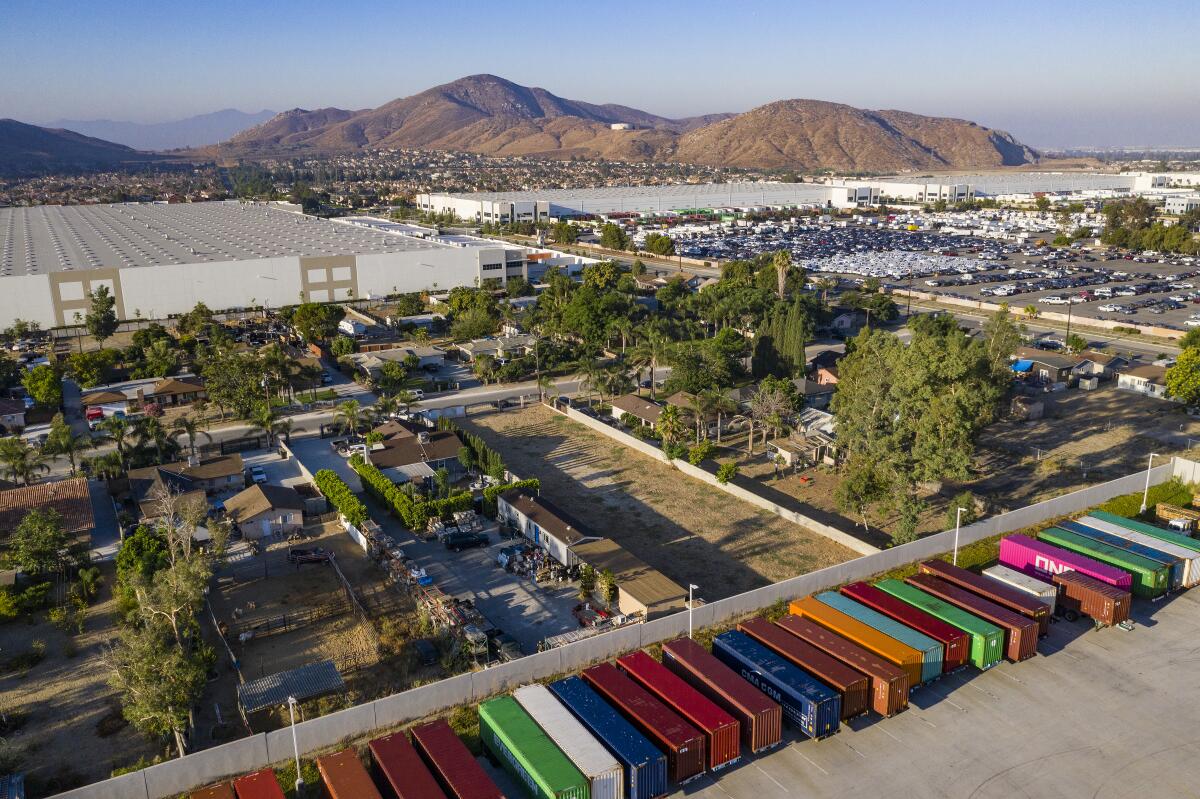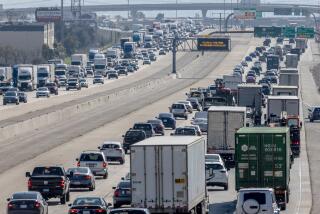Editorial: E-commerce pollution is choking Southern California communities

Growing up in Moreno Valley, Ivette Torres thought it was normal to see tractor trailers rumbling through the neighborhood and to have giant warehouses and truck parking lots located next to homes and schools. When she left home to go to UC Santa Cruz a few years ago, Torres realized her community was far from the norm.
Since the 1980s, Moreno Valley and other inland cities have become hosts to sprawling repositories for goods. Developers were drawn to the area for its cheap land, its proximity to rail lines and highways, and the easy drive from the ports of Los Angeles and Long Beach. In the last decade, as trade and e-commerce increased, the Inland Empire has quickly transformed into a goods-movement mecca, adding nearly 175 million square feet of industrial space since 2010. Amazon alone has built 19 facilities in the area.
“Warehousing was always a thing,” said Torres, who is a now a researcher and advocate working to clean up the goods movement industry. “Coming home and seeing every lot that was empty before was now a warehouse was a surprise.”
That growth has come with few protections for the residents living near warehouses and distribution centers. The warehouses themselves are not big polluters. The problem is the thousands and thousands of heavy-duty trucks that come and go each day, traveling through their communities and idling outside warehouses.
Those trucks leave a trail of toxic diesel soot and smog-forming pollutants that are suffocating the region, which has the worst air quality in the country. Plus, warehouses tend to locate in low-income communities of color that already had higher levels of air pollution, which only exacerbates existing health problems. And yet despite all those concerns, city and county elected officials throughout the region have continued to rubber-stamp warehouse developments with little regard to the public health or environmental impacts.
Now, after years of unfettered growth in the logistics industry, the South Coast Air Quality Management District is considering a first-of-its-kind rule to reduce the pollution associated with warehouses. Although the air district cannot regulate trucks directly — the state and federal government set the emissions standards — the region can use its authority to regulate the facilities that are magnets for trucks. It’s just never done so. That makes the proposed rule, which the air district will take up this week, especially significant.
If approved, the rule would apply to almost 3,000 large warehouses in Los Angeles, Orange, Riverside and San Bernardino counties. The operators of those warehouses would be required to select from a menu of pollution-cutting measures, such as investing in zero-emission trucks and electric fork lifts, installing solar panels and providing chargers for electric vehicles. The number of measures required would be determined by the number of diesel truck trips to their warehouses.
Facilities could reduce their obligation by persuading cargo companies to transport their goods in clean trucks. Alternatively, warehouse operators could pay a fee that would be used to subsidize the purchase of clean trucks. Either way, the effect would be more clean trucks on the road sooner than would otherwise be required under state and federal laws. That would help reduce smog-forming emissions and toxic particles across the region but especially in the neighborhoods closest to warehouses, ports and other goods movement centers.
Naturally, businesses across the logistics industry are lining up in opposition to the proposal. Warehouse operators have objected, saying they have no control over the independently owned trucks that pick up and drop off cargo at their facilities. That’s true in some respects, which is why the regulation is designed to give warehouse many different ways to reduce emissions.
Other business groups have argued the proposal would raise the cost of moving goods through Southern California and spur warehouse operators to build in Las Vegas or the Central Valley instead. But a socioeconomic analysis by the air district suggests the cost of complying would be minimal and have little effect on the booming logistics industry. Besides, the focusing on market share ignores the public health and environmental costs that Southern California residents have been forced to live with so that consumers elsewhere in the country can enjoy fast and free shipping.
Demanding more from the goods movement industry is not only necessary, it’s inevitable.
Last week, for example, the developer of the massive World Logistics Center project in Moreno Valley agreed to invest about $47 million in electric vehicles and equipment, solar panels, electric vehicle chargers and other measures in order to settle a long-standing lawsuit over the environmental impacts.
Also, California has already committed to a clean transportation future, including phasing in zero-emission trucks starting in 2024, as part of the state’s fight to slow climate change. President Biden also wants to halve greenhouse gas emissions by 2030, which will require a dramatically cleaner transportation sector.
But Southern California can’t wait for those state and federal policies to kick in. The region is facing a 2023 deadline to slash smog-forming pollutants or face federal penalties. Plus, it’s inhumane to consign residents here to unhealthy levels of pollution that can permanently damage children’s lungs and raise adults’ risk of heart attacks and strokes. Southern California’s air quality has been on the decline for several years now, with the worst effects felt in San Bernardino, Riverside and other inland areas — the very communities that will benefit from a strong warehouse rule.
Despite the glaring need for action to clean up the region’s air quality, passage of a strong warehouse rule is not certain. The air district’s governing board, which is made up of local elected officials, has too often bent to industry demands and delayed necessary regulations to cut emissions. That cannot continue.
Torres said she’s watched the exponential growth of e-commerce industry and is frustrated that companies and political leaders are quibbling over the cost of investing in clean technology.
“We shouldn’t put a price on the community’s health,” Torres said. “The air pollution is so bad from morning to night. It’s terrible to tell a parent you have to keep your child inside all summer.” That’s a message the air district needs to hear.
More to Read
A cure for the common opinion
Get thought-provoking perspectives with our weekly newsletter.
You may occasionally receive promotional content from the Los Angeles Times.






